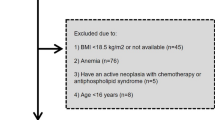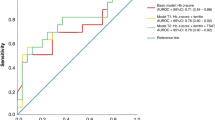Abstract
Background
Obesity is often associated with iron deficiency in children and adolescents. We aimed to study the effect of an 8-month physical exercise (PE) intervention on hepcidin and other markers of inflammation and on iron status in overweight/obese children and adolescents.
Methods
Seventy-three overweight/obese children and adolescents participated in the 8-month-long longitudinal study. They were divided into two groups according to their participation in an after-school PE program: the PE group (n=44) and the control group (n=29). Hepcidin, interleukin (IL)-6, C-reactive protein (CRP), iron, ferritin, transferrin, and soluble transferrin receptor (sTfR) were evaluated.
Results
At baseline, IL-6 correlated positively with hepcidin and negatively with iron and transferrin saturation, suggesting that increasing adiposity associates with increasing IL-6 and hepcidin synthesis, reducing iron availability. After 8 months, the PE group showed a decrease in BMI z-score (P=0.003), body fat mass (P=0.012), CRP (P=0.002), IL-6 (P=0.048), ferritin (P=0.013), hepcidin (P=0.040), and sTfR (P=0.010), and an increase in iron concentration (P=0.002). Moreover, the PE group, when compared with the control group, showed lower weight (P=0.026), BMI (P=0.040), waist circumference (P=0.010), and waist-to-height ratio (P=0.046).
Conclusion
We showed that an 8-month-long intervention at school allowed a reduction in BMI z-score and an improvement in inflammation, reducing hepcidin levels and the disturbances in iron status.
Similar content being viewed by others
Log in or create a free account to read this content
Gain free access to this article, as well as selected content from this journal and more on nature.com
or
References
McLean E, Cogswell M, Egli I, Wojdyla D, de Benoist B . Worldwide prevalence of anaemia, WHO vitamin and mineral nutrition information system, 1993-2005. Public Health Nutr 2009;12:444–54.
Nead KG, Halterman JS, Kaczorowski JM, Auinger P, Weitzman M . Overweight children and adolescents: a risk group for iron deficiency. Pediatrics 2004;114:104–8.
Yanoff LB, Menzie CM, Denkinger B et al. Inflammation and iron deficiency in the hypoferremia of obesity. Int J Obes 2007;31:1412–9.
Lecube A, Carrera A, Losada E, Hernandez C, Simo R, Mesa J . Iron deficiency in obese postmenopausal women. Obesity 2006;14:1724–30.
Zimmermann MB, Zeder C, Muthayya S et al. Adiposity in women and children from transition countries predicts decreased iron absorption, iron deficiency and a reduced response to iron fortification. Int J Obes 2008;32:1098–104.
Pinhas-Hamiel O, Newfield RS, Koren I, Agmon A, Lilos P, Phillip M . Greater prevalence of iron deficiency in overweight and obese children and adolescents. Int J Obes Relat Metab Disord 2003;27:416–8.
Tussing-Humphreys LM, Liang H, Nemeth E, Freels S, Braunschweig CA . Excess adiposity, inflammation, and iron-deficiency in female adolescents. J Am Diet Assoc 2009;109:297–302.
Tussing-Humphreys LM, Nemeth E, Fantuzzi G et al. Elevated systemic hepcidin and iron depletion in obese premenopausal females. Obesity 2010;18:1449–56.
Ausk KJ, Ioannou GN . Is obesity associated with anemia of chronic disease? A population-based study. Obesity 2008;16:2356–61.
Coimbra S, Catarino C, Santos-Silva A . The role of adipocytes in the modulation of iron metabolism in obesity. Obes Rev 2013;14:771–9.
Anty R, Dahman M, Iannelli A et al. Bariatric surgery can correct iron depletion in morbidly obese women: a link with chronic inflammation. Obes Surg 2008;18:709–14.
Piperno A, Mariani R, Trombini P, Girelli D . Hepcidin modulation in human diseases: from research to clinic. World J Gastroenterol 2009;15:538–51.
Koorts AM, Viljoen M . Ferritin and ferritin isoforms I: structure-function relationships, synthesis, degradation and secretion. Arch Physiol Biochem 2007;113:30–54.
Wrighting DM, Andrews NC . Interleukin-6 induces hepcidin expression through STAT3. Blood 2006;108:3204–09.
Verga Falzacappa MV, Vujic Spasic M, Kessler R, Stolte J, Hentze MW, Muckenthaler MU . STAT3 mediates hepatic hepcidin expression and its inflammatory stimulation. Blood 2007;109:353–8.
Nemeth E, Rivera S, Gabayan V et al. IL-6 mediates hypoferremia of inflammation by inducing the synthesis of the iron regulatory hormone hepcidin. J Clin Invest 2004;113:1271–6.
Wish JB . Assessing iron status: beyond serum ferritin and transferrin saturation. Clin J Am Soc Nephrol 2006;1 (Suppl 1): S4–S8.
Baumgartner J, Smuts CM, Aeberli I, Malan L, Tjalsma H, Zimmermann MB . Overweight impairs efficacy of iron supplementation in iron-deficient South African children: a randomized controlled intervention. Int J Obes) 2013;37:24–30.
Nascimento H, Costa E, Rocha S et al. Adiponectin and markers of metabolic syndrome in obese children and adolescents: impact of 8-mo regular physical exercise program. Pediatr Res 2014;76:159–165.
Amato A, Santoro N, Calabro P et al. Effect of body mass index reduction on serum hepcidin levels and iron status in obese children. Int J Obes 2010;34:1772–4.
Gong L, Yuan F, Teng J et al. Weight loss, inflammatory markers, and improvements of iron status in overweight and obese children. J Pediatr 2014;164 (795-800): e2.
Nascimento H, Alves AI, Medeiros AF et al. Impact of a school-based intervention protocol - ACORDA Project - on adipokines in an overweight and obese pediatric population. Pediatr Exerc Sci 2016;28:407–16.
de Onis M, Onyango AW, Borghi E, Siyam A, Nishida C, Siekmann J . Development of a WHO growth reference for school-aged children and adolescents. Bull World Health Organ 2007;85:660–7.
Tanner JM . Normal growth and techniques of growth assessment. Clin Endocrinol Metab 1986;15:411–451.
WHO. Global Recommendations on Physical Activity for Health. World Health Organization: Geneva, Switzerland, 2010.
Janssen I . Guidelines for physical activity in children and young people. Appl Physiol Nutr Metab 2007;32 (Suppl 2F): S122–35.
Strong WB, Malina RM, Blimkie CJ et al. Evidence based physical activity for school-age youth. J Pediatr 2005;146:732–7.
Grandone A, Marzuillo P, Perrone L, Del Giudice EM . Iron metabolism dysregulation and cognitive dysfunction in pediatric obesity: is there a connection? Nutrients 2015;7:9163–70.
Hamza RT, Hamed AI, Kharshoum RR . Iron homeostasis and serum hepcidin-25 levels in obese children and adolescents: relation to body mass index. Horm Res Paediatr 2013;80:11–7.
Aeberli I, Hurrell RF, Zimmermann MB . Overweight children have higher circulating hepcidin concentrations and lower iron status but have dietary iron intakes and bioavailability comparable with normal weight children. Int J Obes 2009;33:1111–7.
del Giudice EM, Santoro N, Amato A et al. Hepcidin in obese children as a potential mediator of the association between obesity and iron deficiency. J Clin Endocrinol Metab 2009;94:5102–7.
Nicolas G, Chauvet C, Viatte L et al. The gene encoding the iron regulatory peptide hepcidin is regulated by anemia, hypoxia, and inflammation. J Clin Invest 2002;110:1037–44.
Tussing-Humphreys L, Pusatcioglu C, Nemeth E, Braunschweig C . Rethinking iron regulation and assessment in iron deficiency, anemia of chronic disease, and obesity: introducing hepcidin. J Acad Nutr Diet 2012;112:391–400.
Bekri S, Gual P, Anty R et al. Increased adipose tissue expression of hepcidin in severe obesity is independent from diabetes and NASH. Gastroenterology 2006;131:788–96.
Cepeda-Lopez AC, Allende-Labastida J, Melse-Boonstra A et al. The effects of fat loss after bariatric surgery on inflammation, serum hepcidin, and iron absorption: a prospective 6-mo iron stable isotope study. Am J Clin Nutr 2016;104:1030–8.
Tussing-Humphreys LM, Nemeth E, Fantuzzi G et al. Decreased serum hepcidin and improved functional iron status 6 months after restrictive bariatric surgery. Obesity 2010;18:2010–6.
Nascimento H, Costa E, Rocha-Pereira P et al. Cardiovascular risk factors in portuguese obese children and adolescents: impact of small reductions in body mass index imposed by lifestyle modifications. Open Biochem J 2012;6:43–50.
Acknowledgements
This work was funded by European Regional Development Fund (FEDER, Europe) funds through the Operational Competitiveness Programme (COMPETE, Portugal), and by National Funds through Fundação para a Ciência e a Tecnologia (FCT, Portugal) under the project FCOMP-01-0124-FEDER-028613 (PTDC/DTP-DES/0393/2012).
Author information
Authors and Affiliations
Corresponding authors
Ethics declarations
Competing interests
The authors declare no conflict of interest.
Rights and permissions
About this article
Cite this article
Coimbra, S., Catarino, C., Nascimento, H. et al. Physical exercise intervention at school improved hepcidin, inflammation, and iron metabolism in overweight and obese children and adolescents. Pediatr Res 82, 781–788 (2017). https://doi.org/10.1038/pr.2017.139
Received:
Accepted:
Published:
Issue date:
DOI: https://doi.org/10.1038/pr.2017.139
This article is cited by
-
High prevalence of anemia and overweight among women workers in three palm plantations in Indonesia: a cross sectional study
Journal of Health, Population and Nutrition (2024)
-
Iron and zinc homeostases in female rats with physically active and sedentary lifestyles
BioMetals (2021)
-
Chronic intermittent hypobaric hypoxia improves markers of iron metabolism in a model of dietary-induced obesity
Journal of Inflammation (2020)
-
Carnosine supplementation reduces plasma soluble transferrin receptor in healthy overweight or obese individuals: a pilot randomised trial
Amino Acids (2019)



